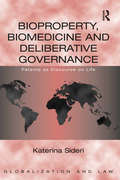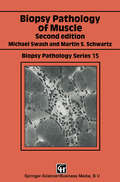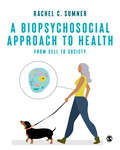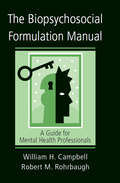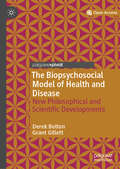- Table View
- List View
Bioprocessing of Viral Vaccines
by Amine Kamen Laura CerveraThis book focuses on cell culture-produced viral vaccines to meet the needs of the rapidly expanding research and development in academia and industry in the field. This book introduces the basic principles of vaccination and the manufacturing of viral vaccines. Bioprocessing of Viral Vaccines, will provide an overview of the advanced strategies needed to respond to the challenges of new and established viral infection diseases. The first few chapters cover the basics of virology and immunology as essential concepts to understand the function and design of viral vaccines. The core of the content is dedicated to process development, including upstream processing and cell culture of viral vaccines, downstream processing, and extensive analytical technologies specific to viral vaccines. Advanced process analytical technologies (PAT) and Quality by Design (QbD) concepts are also introduced in the context of vaccine manufacturing. The case studies included cover inactivated, attenuated vaccines exemplified by influenza vaccines, sub-unit vaccines exemplified by Virus Like Particles (VLPs: HPV vaccines) and sub-unit vaccines (Flublock), vectored vaccines: adenoviruses and Vesicular stomatitis Virus (VSV) vectored vaccines, genomic vaccines (DNA and mRNA) vaccines as developed for COVID-19 response in particular and a review of COVID-19 vaccines approved or in advanced clinical trials. This book is aimed at graduate engineers and professionals in the fields of vaccinology, bioprocessing, and biomanufacturing of viral vaccines.
Bioproperty, Biomedicine and Deliberative Governance: Patents as Discourse on Life
by Katerina SideriBiomedical patents have been the subject of heated debate. Regulatory agencies such as the European Patent Office make small decisions with big implications, which escape scrutiny and revision, when they decide who has access to expensive diagnostic tests, whether human embryonic stem cells can be traded in markets, and under what circumstances human health is more important than animal welfare. Moreover, the administration of the Trade Related Aspects of Intellectual Property Rights by the World Trade Organization has raised considerable disquiet as it has arguably created grave health inequities. Those doubting the merits of the one size fits all approach ask whether priority should be given to serving the present needs of populations in dire need of medication or to promoting global innovation. The book looks in detail into the legal issues and ethical debates to ask the following three main questions: First, what are the ideas, goals, and broader ethical visions that underpin questions of governance and the legal reasoning employed by administrative agencies? Second, how can we democratize the decision making process of technocratic institutions such as the European Patent Office? Finally, how can we make the global intellectual property system more equitable? In answering these questions the book seeks to contribute to our understanding of the role and function of regulatory agencies in the regulation of the bioeconomy, explains the process of interpretation of legal norms, and proposes ways to rethink the reform of the patent system through the lens of legitimacy.
Bioproperty, Biomedicine and Deliberative Governance: Patents as Discourse on Life (Globalization And Law Ser.)
by Katerina SideriBiomedical patents have been the subject of heated debate. Regulatory agencies such as the European Patent Office make small decisions with big implications, which escape scrutiny and revision, when they decide who has access to expensive diagnostic tests, whether human embryonic stem cells can be traded in markets, and under what circumstances human health is more important than animal welfare. Moreover, the administration of the Trade Related Aspects of Intellectual Property Rights by the World Trade Organization has raised considerable disquiet as it has arguably created grave health inequities. Those doubting the merits of the one size fits all approach ask whether priority should be given to serving the present needs of populations in dire need of medication or to promoting global innovation. The book looks in detail into the legal issues and ethical debates to ask the following three main questions: First, what are the ideas, goals, and broader ethical visions that underpin questions of governance and the legal reasoning employed by administrative agencies? Second, how can we democratize the decision making process of technocratic institutions such as the European Patent Office? Finally, how can we make the global intellectual property system more equitable? In answering these questions the book seeks to contribute to our understanding of the role and function of regulatory agencies in the regulation of the bioeconomy, explains the process of interpretation of legal norms, and proposes ways to rethink the reform of the patent system through the lens of legitimacy.
Bioprospecting of Enzymes in Industry, Healthcare and Sustainable Environment
by Hrudayanath Thatoi Sonali Mohapatra Swagat Kumar DasThe rapid urbanization and industrialization of developing countries across the globe have necessitated for substantial resource utilization and development in the areas of Healthcare, Environment, and Renewable energy. In this context ,this resourceful book serves as a definitive source of information for the recent developments in application of microbial enzymes in various sectors. It covers applications in fermentation processes and their products, extraction and utilisation of enzymes from various sources and their application in health and biomass conversion for production of value added products. Different chapters discuss various areas of bioprospecting in enzyme technology, and describe why these are the mainstays for industrial production of value added products. The rich compilation of the cutting-edge advances and applications of the modern industrial based techniques hold feasible solutions for a range of current issues in enzyme technology.This book will be of particular interest for scientists, academicians, technical resource persons, engineers and members of industry. Undergraduate and graduate students pursuing courses in the area of industrial biotechnology will find the information in the book valuable. General readers having interest towards biofuels, enzyme technology, fermented food and value added products, phytochemicals and phytopharmaceutical products will also find the book appealing. Readers will discover modern concepts of enzymatic bioprocess technology for production of therapeutics and industrial value added products.
Bioprospecting of Ethnomedicinal Plant Resources: Sustainable Utilization and Restoration
by Gopal Shukla Sumit Chakravarty Jahangeer A. Bhat A. P. DasThe majority of modern drugs are based on phytochemicals produced from ethnomedicinal plants.This new volume provides an understanding of the importance of sustainability and bioprospecting of ethnomedicinal plants for formulating novel chemical compounds and new drugs from raw materials from plants cultivated and collected from the wild for healthcare and nutrition practices. It provides extensive information on medicinal plant diversification, cultivation techniques, biotechnological approaches, and modern and traditional usages. It also provides information for developing new strategies and formulating new policies for the systematic management and conservation of medicinal resources for future use.
Bioprospecting of Ethnomedicinal Plant Resources: Sustainable Utilization and Restoration
The majority of modern drugs are based on phytochemicals produced from ethnomedicinal plants.This new volume provides an understanding of the importance of sustainability and bioprospecting of ethnomedicinal plants for formulating novel chemical compounds and new drugs from raw materials from plants cultivated and collected from the wild for healthcare and nutrition practices. It provides extensive information on medicinal plant diversification, cultivation techniques, biotechnological approaches, and modern and traditional usages. It also provides information for developing new strategies and formulating new policies for the systematic management and conservation of medicinal resources for future use.
Bioprospecting of Tropical Medicinal Plants
by Karuppusamy Arunachalam Xuefei Yang Sreeja Puthanpura SasidharanThis book focuses on natural products, in particular medicinal plants and their derived products, as an indispensable source of bioactive molecules that serve as either drug candidates or lead compounds for drug design and discovery . There are several advantages for plant-derived therapeutics, including wide availability, diverse pharmacological actions, and a generally good profile of safety and tolerability. Over the recent years, there have been numerous reports from clinical studies testifying the efficacy and safety of medicinal plants and phytochemicals in treating human diseases. A plethora of basic studies has also unraveled molecular mechanisms underlying the health benefits of herbal medicines. Nevertheless, issues such as identification of bioactive ingredients, standardization of the products, and drug interactions remain to be systematically documented. Bioprospecting of Tropical Medicinal Plants represents a comprehensive analysis of natural products, mainly medicinal plants and phytochemicals. It includes detailed medicinal properties and pharmacological action from in vitro models to clinical trials. The goal is to present the readers a carefully curated collection of plant-derived natural products and their underlying molecular mechanisms.
Biopsy Diagnosis of Peripheral Neuropathy
by Juan M Bilbao Robert E SchmidtPeripheral nerve analysis is a challenging task for pathologists, given the advent of new diagnoses and techniques of analysis and the impact of molecular genetics. This book presents a simple, logical method for constructing a differential diagnosis based on pathology and clinical presentation. It also provides advice on the selection of ancillary molecular, immunohistochemical and genetic techniques to establish a definitive diagnosis. Clear, authoritative guidance is offered on diagnosis of the full range of neuropathies with the aid of a wealth of high-quality color photomicrographs and electron micrographs. The pathologist will benefit greatly from the identification of a variety of artifacts and normal structures occasionally encountered in nerve biopsies that need to be distinguished from specific pathologic alterations. This user-friendly, practical text will be an invaluable aid in achieving the most specific diagnosis possible.
Biopsy of Bone in Internal Medicine: An Atlas and Sourcebook (Current Histopathology #21)
by Reiner Bartl Bertha FrischThis comprehensive book, lavishly illustrated with over 700 colour pictures, addresses the subject of bone in internal medicine. It is based on biopsies of bone and first describes the normal range of physiological findings in iliac crest biopsies in young, middle-aged and elderly individuals. The book then deals systematically with the osseous disorders most frequently encountered in internal medicine, and some that would be considered in the differential diagnosis. Numerous up-to-date references are included. The clinical applications of biopsies of bone are emphasized as well as their clinical interpretation; sections on histomorphometry and functional aspects of bone cells are also included. The book will be of particular interest to specialists in internal medicine, endocrinology, nephrology, haematology and oncology, as well as being a bench manual for the practising pathologist.
Biopsy Pathology in Colorectal Disease, 2Ed
by Ian Talbot Ashley Price Manuel Salto-TellezBiopsy Pathology in Colorectal Disease shows how the practising pathologist can extract the maximum of diagnostic value from biopsies of the colon, rectum and anus. With the advances in colonoscopic mucosal biopsy techniques these are amongst the most frequently encountered specimens in hospital histopathology departments. This new edition provides
Biopsy Pathology of Muscle (Biopsy Pathology Series)
by Michael Swash Martin S. SchwartzMuseie biopsy is a long-established technique in clinical practice having been introduced by Duchenne in 1868 (Arch. Gen. Med. , 11, 5-179). However, the needle method used by Duchenne was not generally adopted, although Shank and Hoagland described a similar technique in 1943 (Science, 98, 592), and open muscle biopsy has for long been preferred in clinical practice, even with the advent of newer needle biopsy methods (Bergstrom, 1962, Scand. J. Clin. Lab. Invest. , 14, Suppl. 68, 1-110). The development of enzyme histochemical techniques has contributed greatly to knowledge of muscle pathology. More recently electron microscopy and immunocytochemistry have also been applied to clinical diagnosis of neuromuscular disease. This book is intended to serve as a practical guide in muscle pathology, particularly for histopathologists, and for those in training. As enzyme histochemistry has become more widely available, formalin-fixed methods have become less frequently used in muscle biopsy work. In this new edition of Muscle Biopsy Pathology we have taken account of the advances in classification and histological technique, and in knowledge of neuromuscular diseases, that have emerged since the first editionwas published in 1984. We hope that this book will continue to be used as a practical guide in the diagnosis and understanding of these disorders. 1. Introduction 1. 1 Generalfeatures of muscle The differentiation of musde into red and white types is a feature of all vertebrates and, indeed, of chordates.
Biopsy pathology of muscle (Biopsy Pathology Series)
by Michael Swash Martin S. SchwartzDuring the last 20 years the development of enzyme histochemical techniques has contributed greatly to knowledge of muscle pathology. However, these and other new methods, such as electron microscopy and immunocytochemistry, have only relatively recently become gener ally available for routine use in histopathology. Muscle biopsy is a long-established technique in clinical practice, having been introduced by Duchenne in 1868 (Arch. Gen. Med. , 11, 5-179). However, the needle method used by Duchenne was not generally adopted, although Shank and Hoagland described a similar technique in 1943 (Science, 98, 592). During this time muscle biopsies required a surgical procedure and this was a considerable disincentive to their use. It was not until Bergstrom (1962; Scand. J. Clin. Lab. Invest. , 14, Suppl. 68) and Edwards (1971; Lancet, ii, 593--6) developed a simple biopsy needle suitable for muscle work in connection with exercise physiology that the advantages of needle muscle biopsies came to be appreciated. Since then, muscle biopsies have become a relatively minor procedure. This has led to the increasing use of muscle biopsy in clinical practice, both for diagnosis and for assessing progress in repeated biopsies during the course of a disorder and its treatment. The full range of enzyme histochemical and ultrastructural histological techniques can be applied to these small biopsies and many of the older histological staining methods can also be used. This book is intended to serve as a practical guide in muscle pathology, particularly for histopathologists, and for those in training.
Biopsy Pathology of the Bronchi (Biopsy Pathology Series)
by Elizabeth M. McDowell Theodore F. BealsBiopsy Pathology of the Bronchi is intended to provide the practicing pathologist with a convenient source of diagnostic information, combined with pertinent clinical patterns and a background of histogenesis. It is hoped that the book will facilitate the accuracy of diagnosis, minimize pitfalls of interpretation and assist in the rapid evaluation of acute and chronic bronchial lesions, including neoplasms. Biopsy is taken in the widest sense and the book includes discussions on cytology, microbiopsies (fine needle aspiration biopsies, curette samples, and biopsies obtained by microforceps) and macrobiopsies, obtained at the time of surgery. Part I of the book deals with the procurement and preparation of bronchial specimens and includes a chapter on fetal development and structure of the normal adult epithelium. In Part II, the histopathology of numerous bronchial diseases are described in detail. Emphasis is placed on the diagnostic features of human lesions' which are illustrated by numerous high quality light and electron micrographs. Understanding normal bron chial structure, cell kinetics, and modulations of phenotypic expression provide insight into many pathological processes. Therefore, although emphasis is placed on the diagnostic features of human disease, the histopathology of corresponding lesions in experimental animals is dis cussed where this provides information helpful in the interpretation of the human lesions. Elizabeth M. McDowell Baltimore Theodore F. Beals Ann Arbor 1985 viii Acknowledgments We give thanks to friends and colleagues who reviewed one or more chapters for us during the writing of this book.
Biopsy Pathology of the Lymphoreticular System (Biopsy Pathology Series)
by Dennis H. Wright Peter G. IsaacsonBiopsychologie von A bis Z (Springer-Lehrbuch)
by Clemens KirschbaumBiopsychologie von A bis Z – von Acetylcholinesterase über Hypogeusie bis hin zu Zytosol. Hier finden Sie alle Fachbegriffe zum schnellen Nachschlagen. Biopsychologie ist ein extrem spannendes Fach, verfügt aber vermutlich über die höchste Anzahl an Fachbegriffen. Für dieses Buch definierten 30 Studenten und Studentinnen über 2000 biopsychologische Fachbegriffe. Der Experte Clemens Kirschbaum prüfte die Korrektheit. Sämtliche Beschreibungen sind leicht verständlich, so exakt wie nötig und dabei so einfach wie möglich formuliert. Sie sind alphabetisch sortiert und mit englischen Übersetzungen versehen. Plus: Online-Version im Internet.
A Biopsychosocial Approach to Health: From Cell to Society
by Rachel C. SumnerThis unique text takes a holistic approach to show you how different biological and medical aspects of health operate at the cellular level all the way up to the societal level, and back again. It explains key biological aspects of health at the cellular level (such as epigenetics and oxidative stress) to give you a solid understanding of how health is created in the context of the person, before working upwards to examine public health issues ranging from cardiovascular disease to unemployment and loneliness. Throughout the text, you will encounter a diverse range of cross-cultural examples, real-world scenarios and key questions which will help you put the theories and cell-to-society perspective you have learned into practice. With interdisciplinary perspectives from psychoneuroimmunology and epidemiology, this book offers an integrated consideration of health and its biopsychosocial determinants. It is a must-read for students of health psychology, applied psychology, nursing, and public health. Rachel C. Sumner is a psychobiologist and chartered psychologist with the British Psychological Society Division of Health Psychology and a senior research fellow at Cardiff Metropolitan University.
A Biopsychosocial Approach to Health: From Cell to Society
by Rachel C. SumnerThis unique text takes a holistic approach to show you how different biological and medical aspects of health operate at the cellular level all the way up to the societal level, and back again. It explains key biological aspects of health at the cellular level (such as epigenetics and oxidative stress) to give you a solid understanding of how health is created in the context of the person, before working upwards to examine public health issues ranging from cardiovascular disease to unemployment and loneliness. Throughout the text, you will encounter a diverse range of cross-cultural examples, real-world scenarios and key questions which will help you put the theories and cell-to-society perspective you have learned into practice. With interdisciplinary perspectives from psychoneuroimmunology and epidemiology, this book offers an integrated consideration of health and its biopsychosocial determinants. It is a must-read for students of health psychology, applied psychology, nursing, and public health. Rachel C. Sumner is a psychobiologist and chartered psychologist with the British Psychological Society Division of Health Psychology and a senior research fellow at Cardiff Metropolitan University.
A Biopsychosocial Approach to Health: From Cell to Society
by Rachel C. SumnerThis unique text takes a holistic approach to show you how different biological and medical aspects of health operate at the cellular level all the way up to the societal level, and back again. It explains key biological aspects of health at the cellular level (such as epigenetics and oxidative stress) to give you a solid understanding of how health is created in the context of the person, before working upwards to examine public health issues ranging from cardiovascular disease to unemployment and loneliness. Throughout the text, you will encounter a diverse range of cross-cultural examples, real-world scenarios and key questions which will help you put the theories and cell-to-society perspective you have learned into practice. With interdisciplinary perspectives from psychoneuroimmunology and epidemiology, this book offers an integrated consideration of health and its biopsychosocial determinants. It is a must-read for students of health psychology, applied psychology, nursing, and public health. Rachel C. Sumner is a psychobiologist and chartered psychologist with the British Psychological Society Division of Health Psychology and a senior research fellow at Cardiff Metropolitan University.
Biopsychosocial Approaches in Primary Care: State of the Art and Challenges for the 21st Century
by Hoyle LeighST MEDICINE IN A CHANGING UNIVERSE AT THE THRESHOLD OF THE 21 CENTURY Hoyle Leigh, M. D. I Professor ofPsychiatry San Francisco, University ofCalifornia, and Fresno VAMedical Center INTRODUCTION During my lifetime, the universe has changed beyond recognition. The universe into 111 which I was born, in the first halfofthe 20 century, was still infinite, permanent, orderly, and tranquil --- a universe that worked like a masterfully constructed clock. Matter and energy followed Newton's lawsofconservation. Shortly after my birth, Hiroshima proved, with a big bang, that matter was no longer permanent, everything was relative. Einstein had also shown thateverything that happened was local, that is, there was an event horizon beyond which no information could reach as nothing can travel faster than light. When I was growing up, the moon was for lovers, and going there was an impossible dream. Cosmologically, the Big Bang theory that postulates that the universe was born out ofan explosion some 10-15 billion years ago from a primordial point won over steady state. Ithas been expanding ever since, although the ultimate fateofthe universe is still unknown whetherit will keep on expanding resulting in aperpetual stateofheat death, or will at some point startcontracting, resulting in a big crunch ofgravitational collapse ending in a single black hole out ofspace, time, and existence. Quantum theory has defeated even Einstein's genius and proven that God indeed plays dice.
Biopsychosocial Approaches to Understanding Health in South Asian Americans (Cross-Cultural Research in Health, Illness and Well-Being)
by Edward C. Chang Marisa J. PereraThis volume is the first comprehensive and interdisciplinary text to holistically improve understanding of the health of South Asians residing in the United States by considering biological, psychological, and sociocultural factors of health. The vast literatures of diverse fields – psychology, medicine, public health, social work, and health policy – are integrated by leading scholars, scientists, and practitioners in these areas to explore the impact of South Asian cultural factors on health, health risk, and illness. Chapters incorporate available theoretical and empirical information on the status of chronic health conditions in South Asians in the United States, with consideration of future directions to improve understanding of the health of this group. Cultural and ethnic insights imperative for clinical/community/medical practitioners to provide effective and culturally-appropriate care and treatment from an interdisciplinary lens are provided.
Biopsychosocial Factors of Stress, and Mindfulness for Stress Reduction
by Holly Hazlett-StevensThis volume brings together basic research on the nature of stress reactivity with up-to-date research on the effectiveness and mechanisms of mindfulness interventions. The chapters review the major research areas that elucidate the impact of stress reactivity on health, and explore the mechanisms and effectiveness of mindfulness-based approaches for stress reduction and improved physical and emotional health. The first section examines biopsychosocial mechanisms of stress reactivity such as allostasis and allostatic load, neurobiology of stress, biology of the “fight-or-flight” and “tend-and-befriend” responses, and psychoneuroimmunology. This section concludes by addressing the roles of perception and appraisal, including the role of perceived threat in stress reactivity as well as the role that negative perceptions of the stress response itself play in compromising health. The second section opens with review of leading psychological models of mindfulness, including self-regulation, reperceiving, and the Intention, Attention, Attitude (IAA) triaxiomatic model. Subsequent chapters discuss mindfulness-based interventions and mechanisms of change for stress and related clinical conditions including chronic pain, traumatic stress, anxiety and related disorders, and clinical depression. The final chapter reviews possible neural networks and brain mechanisms associated with mindfulness meditation practice. As the research on stress reactivity and mindfulness-based stress reduction continues to proliferate, this book offers readers a single volume covering the most relevant information across this vast terrain. Other available volumes offer in-depth coverage of stress research with little mention of mindfulness and stress reduction. Conversely, many texts on the topic of mindfulness and mindfulness-based interventions do not adequately cover the biopsychosocial processes of stress reactivity.
The Biopsychosocial Formulation Manual: A Guide for Mental Health Professionals
by William H. Campbell Robert M. RohrbaughBased on George Engel’s model, The Biopsychosocial Formulation Manual presents ways to help psychiatry residents and students effectively gather and organize patient data to arrive at a complete mental health history in a limited timeframe. While most current models only take one factor into account, Campbell and Rohrbaugh emphasize and analyze three essential components (biological, social, and psychological). The process of identifying pertinent data for each component of the biopsychosocial formulation is explicated in detail. A separate section outlines how to use the biopsychosocial formulation to generate treatment recommendations. This volume includes a complete package for practicing the biopsychosocial method; this easy-to-use guide includes a data record sheet and a companion CD to facilitate organization and assessment, appealing to both the psychiatric professional and the trainee.
The Biopsychosocial Formulation Manual: A Guide for Mental Health Professionals
by William H. Campbell Robert M. RohrbaughBased on George Engel’s model, The Biopsychosocial Formulation Manual presents ways to help psychiatry residents and students effectively gather and organize patient data to arrive at a complete mental health history in a limited timeframe. While most current models only take one factor into account, Campbell and Rohrbaugh emphasize and analyze three essential components (biological, social, and psychological). The process of identifying pertinent data for each component of the biopsychosocial formulation is explicated in detail. A separate section outlines how to use the biopsychosocial formulation to generate treatment recommendations. This volume includes a complete package for practicing the biopsychosocial method; this easy-to-use guide includes a data record sheet and a companion CD to facilitate organization and assessment, appealing to both the psychiatric professional and the trainee.
The Biopsychosocial Model of Health and Disease: New Philosophical and Scientific Developments
by Derek Bolton Grant GillettThis open access book is a systematic update of the philosophical and scientific foundations of the biopsychosocial model of health, disease and healthcare. First proposed by George Engel 40 years ago, the Biopsychosocial Model is much cited in healthcare settings worldwide, but has been increasingly criticised for being vague, lacking in content, and in need of reworking in the light of recent developments. The book confronts the rapid changes to psychological science, neuroscience, healthcare, and philosophy that have occurred since the model was first proposed and addresses key issues such as the model’s scientific basis, clinical utility, and philosophical coherence. The authors conceptualise biology and the psychosocial as in the same ontological space, interlinked by systems of communication-based regulatory control which constitute a new kind of causation. These are distinguished from physical and chemical laws, most clearly because they can break down, thus providing the basis for difference between health and disease. This work offers an urgent update to the model’s scientific and philosophical foundations, providing a new and coherent account of causal interactions between the biological, the psychological and social.

